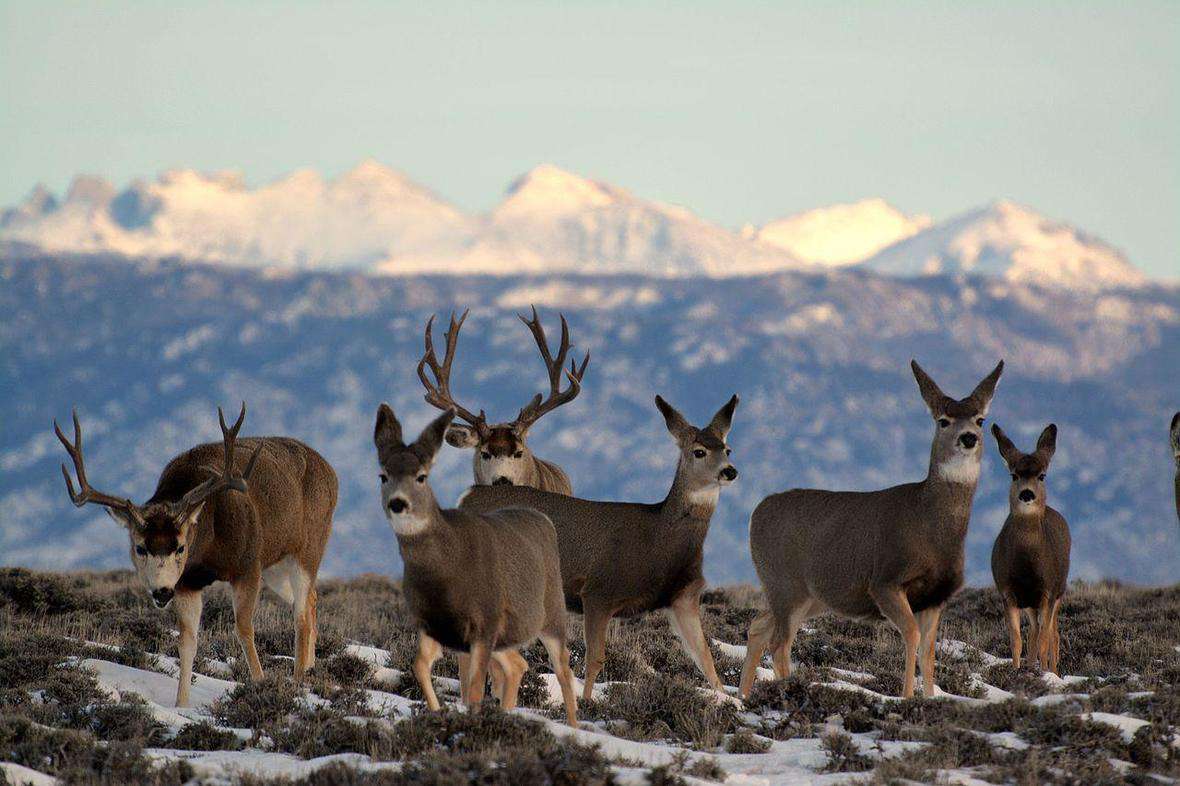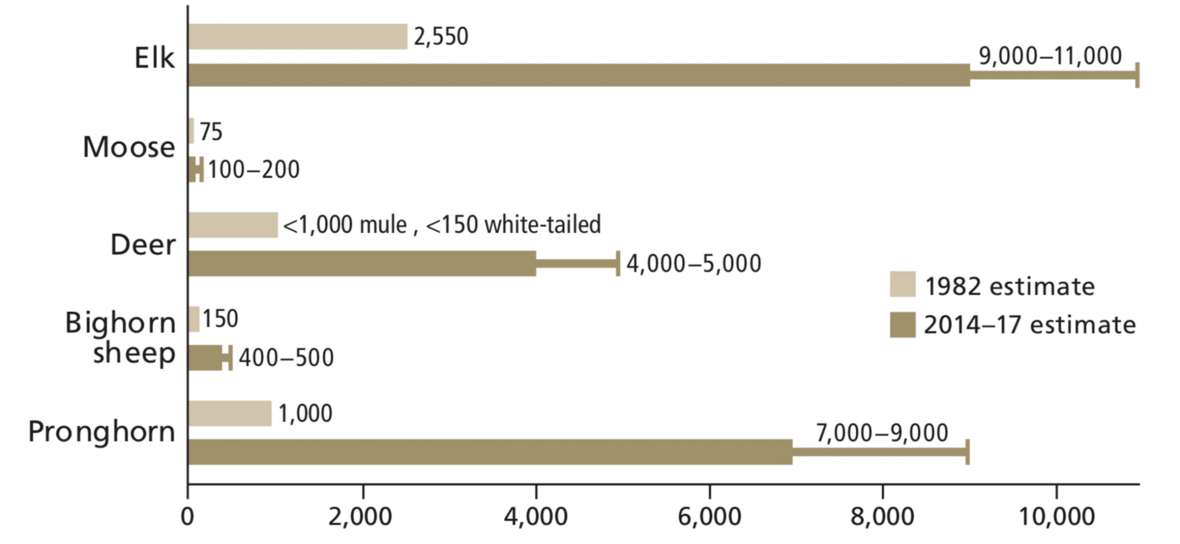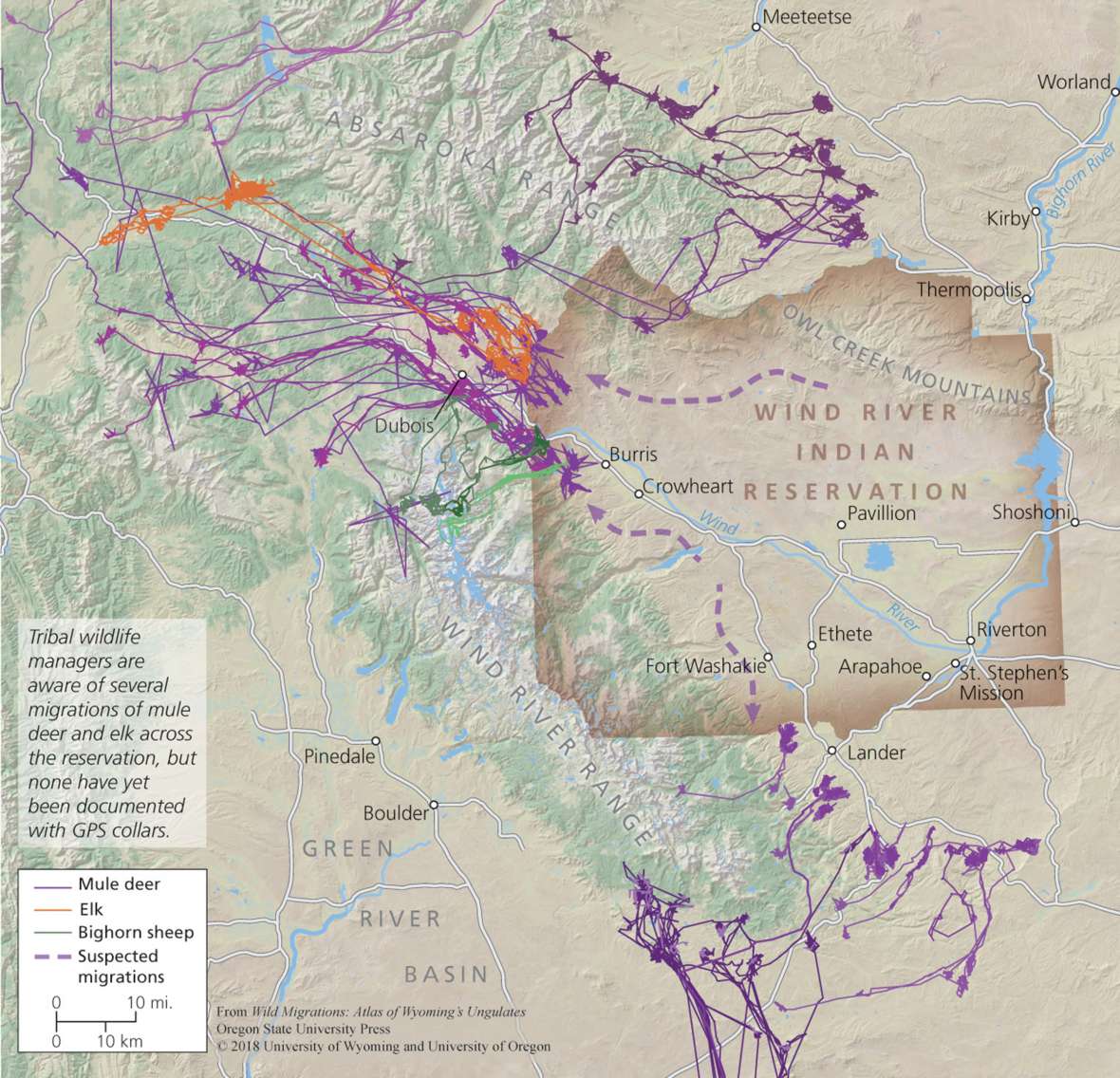- Home
- Encyclopedia
- Managing Game On The Wind River Reservation
Managing Game on the Wind River Reservation
Elk, deer, moose, mule deer, bighorn sheep, pronghorn and other wild ungulates that migrate freely across Wyoming’s vast landscapes also cross more than two million acres of tribal lands on the Wind River Indian Reservation in central Wyoming. Here tribal sovereignty, the political authority retained by the Eastern Shoshone and Northern Arapaho since before Wyoming statehood, influences wildlife conservation dynamics.
The Shoshone and Arapaho have authority to manage game on the reservation under tribal regulations. The joint Eastern Shoshone and Northern Arapaho Tribal Game and Fish Department manages big game species. Since 1972, U.S. Fish and Wildlife Service biologists have assisted the tribes with big game management. Within the reservation, the Wyoming Game and Fish Department has a management role only on private property owned by non-Indians, such as the lands of the Riverton Reclamation Project.
The tribes were early to recognize the importance of undeveloped habitat for wildlife. In the late 1930s, decades before the passage of the 1964 Wilderness Act, they created the Wind River Roadless Area, which prohibited development in a prime hunting ground encompassing 188,000 acres of the Wind River Range.

Game numbers fluctuate
Game populations on the Wind River Indian Reservation fluctuated under a variety of management regimes throughout the 20th century. In 1906, lands north of the Wind River were opened for non-Indian homesteading. For the next 35 years, the state of Wyoming regulated hunting seasons and harvest quotas north of the river. Pius Moss, an Arapaho elder, said this led to plentiful game in that area, particularly in the Owl Creek Mountains. Meanwhile, subsistence hunting by tribal members reduced game numbers south of the Wind River.
After 1939, wildlife management on the northern portion of the reservation returned to the tribes. Ungulates rebounded when the tribes instituted a game code in 1948, restricting harvest to one bull elk and one buck deer during a September–December season. In 1953, the tribes rescinded the code, defaulting to unrestricted harvest.
In 1979 and 1980, U.S. Fish and Wildlife Service biologist Bruce Smith interviewed tribal members who said game numbers had further declined with 4-wheel-drive travel, high-powered rifles, and other factors. Fish and Wildlife Service biologists and the Tribal Game and Fish Department counted low numbers during aerial surveys in the late 1970s. They recommended regulating hunting to boost game populations.
Leaders of both tribes drafted a new game code in 1979 to reinstate harvest quotas and hunting seasons. The concept grew controversial due to differing perspectives on tribal sovereignty, subsistence hunting rights, game conservation and the accuracy of wildlife surveys. The Shoshone Tribe adopted the game code and several Arapaho Business Council members supported it, but the Arapaho General Council, an assembly of tribal voters, voted not to adopt it. Ultimately a U.S. District Court ruling ended the stalemate between the tribes, and the code was implemented in 1984.
Today some who opposed the game code still feel it was unwarranted. Others assert the code restored migratory big game populations to numbers that allow sustainable harvest. As of 2017, the reservation was home to about 10,000 elk, an increase from the U.S. Fish and Wildlife Service estimate of 2,550 in 1982. Today, 1,000 Shoshone and Arapaho tribal members actively hunt big game on the reservation.
Governmental, tribal wildlife agencies work together
In the decades following the enactment of the game code, the Tribal Game and Fish Department worked with the Wyoming Game and Fish Department and the U.S. Fish and Wildlife Service to release pronghorn and bighorn sheep on the reservation to boost their numbers.
Northern Arapaho leaders started planning to reintroduce Yellowstone bison near Wind River Canyon in 2009, but ultimately the Arapaho General Council decided against it, largely due to concerns of potential brucellosis transmission to cattle. The disease can cause cattle to abort their young. In 2016 and 2017, the Eastern Shoshone Tribe reintroduced 20 bison to the reservation, the start of what some hope will one day become a much bigger herd of wild, free-roaming bison.
Through all these changes, migratory ungulates—and more recently grizzlies and wolves—have moved freely across the boundaries of the reservation and into the mountains of the Greater Yellowstone Ecosystem. In 2018, the Tribal Game and Fish Department, U.S. Fish and Wildlife Service, and the University of Wyoming began mapping elk- and deer-migration corridors on the Wind River Indian Reservation in detail, gathering information that will aid management on these interconnected landscapes in the heart of Wyoming.
Recovery of Ungulate Herds

Migration Routes near Wind River

Editor’s note: Thanks to the following consultants on the Wind River Indian Reservation who worked with the author on the Wild Migrations project: James Trosper (Eastern Shoshone, Northern Arapaho), High Plains American Indian Research Institute, University of Wyoming; Eastern Shoshone Tribe: Jason Baldes, Curtis Barney, Roberta Engavo, Zedora Enos, John Washakie; Northern Arapaho Tribe: Mark Soldier Wolf, Herbert Welsh, Crawford White. And thanks to Wyoming Humanities, which supported development of this article.
Resources
Sources
- “Brucellosis.” Cattle Today, Accessed Jan. 18, 2019 at http://cattletoday.info/brucellosis.htm.
- Bureau of American Ethnology. 1899. “Plates CXVI, CXLVIII, CXXXIII, and CLXXIII.” Eighteenth Annual Report of the Bureau of American Ethnology to the Secretary of the Smithsonian Institution, Part 2, 1896-97. Washington, DC: Government Printing Office.
- Cowell, Andrew, Alonzo Moss Sr., William C’Hair, Lloyd Dewey, and Mark Soldier Wolf. 2006. The Arapaho Project. Places and Placenames of the Arapaho: Culture on the Landscape. Boulder: University of Colorado, Northern Arapaho Tribe and Center for the Study of Indigenous Languages of the West. Online.
- Encyclopedia Staff. 2018. “Colorado Gold Rush.” Colorado Encyclopedia. Online.
- Guinn, Manfred, Beatrice T. Haukaas, Roberta Engavo, and Reba Teran. 2009. Shoshone Language Dictionary: Geographic Areas. Fort Washakie: Eastern Shoshone Cultural Center.
- Hnilicka, P. US Fish and Wildlife Service. Unpublished data.
- Kauffman, M. University of Wyoming. Unpublished data.
- Kauffman, M. J., J. E. Meacham, H. Sawyer, A. Y. Steingisser, W. J. Rudd, and E. Ostlind, editors. 2018. Wild Migrations: Atlas of Wyoming's Ungulates. Oregon State University Press, Corvallis, Oregon.
- Little Bighorn College. 2012. Apsáalooke Place Names Database. Online.
- Middleton, A. University of California, Berkeley. Unpublished data.
- Morris, Meg. 2016. Bison Release, photograph. National Wildlife Federation Tribal Lands Conservation Program, Rocky Mountain Regional Center, Denver, CO. Photographed at the Eastern Shoshone Tribe Buffalo Pasture, Wind River Indian Reservation, WY.
- Nabokov, Peter, and Lawrence L. Loendorf. 2004.
- O’Brien, M.P. et. al., “Brucellosis Transmission between Wildlife and Livestock in the Greater Yellowstone Ecosystem: Inferences from DNA Genotyping. PubMed.gov, Accessed Jan. 18, 2019 at https://www.ncbi.nlm.nih.gov/pubmed/28118557.
- Restoring a Presence: American Indians and Yellowstone National Park. Norman: University of Oklahoma Press.
- Rogers, Alan. 2016. Boys Climb a Fence to Get a Better Look at 10 Wild Bison, photograph, originally published November 3, 2016, in “Wild Bison Return to Wind River Reservation after 131-Year Absence.” Casper-Star Tribune, Casper, WY.
- Shaul, David L. 2012. Eastern Shoshone Working Dictionary. Online.
- Shimkin, Demitri B. 1947. “Wind River Shoshone Ethnogeography.” Anthropological Records 5(4): 254-288.
- Smith, Bruce L. 2010. Wildlife on the Wind: A Field Biologist’s Journey and an Indian Reservation’s Renewal. Logan: Utah State University Press.
- Stewart, Omer. 1957. Boundary of Shoshone Indian Territory, map after 1863 Map by Governor and Acting Superintendent of Indian Affairs in Utah Territory James Doty, Exhibit A in Petition for Docket 326 before the Indian Claims Commission, Digitized by J. Willard Marriott Library, University of Utah, Salt Lake City, UT.
Illustrations
- The photo of the mule deer was taken by the U.S. Bureau of Land Management. Used with thanks.
- The map of migration routes and the graph of ungulate populations on the Wind River Indian Reservation are from pp. 132-133 of Wild Migrations: Atlas of Wyoming’s Ungulates, Oregon State University Press, © 2018 University of Wyoming and University of Oregon. Used with permission and thanks.
